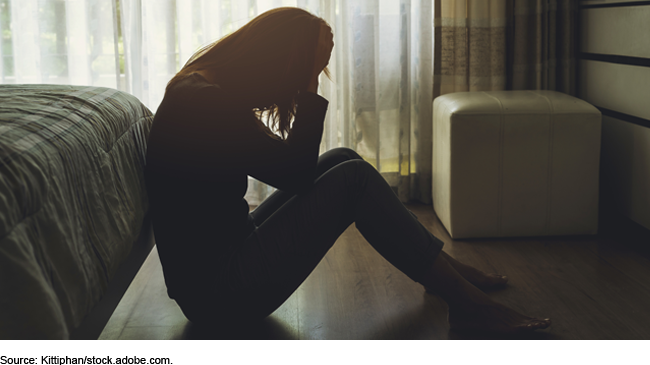Behavioral Health: Patient Access, Provider Claims Payment, and the Effects of the COVID-19 Pandemic
Fast Facts
How has the need for and availability of services for mental health and substance use disorders changed during the COVID-19 pandemic?
Evidence suggests these conditions increased while access to care decreased.
- Centers for Disease Control surveys found about 38% of respondents reported symptoms of anxiety or depression from April 2020 through Feb. 2021—up from about 11% in 2019
- Emergency department visits for overdoses and suicide attempts from mid-March to mid-Oct. 2020 were up 36% and 26%, respectively, from 2019
- Many behavioral health service providers reported increasing demand and decreasing staff sizes

Highlights
What GAO Found
GAO found that there have been longstanding concerns about the availability of behavioral health treatment, particularly for low-income individuals. According to a review of federal data, one potential barrier to accessing treatment has been shortages of qualified behavioral health professionals, particularly in rural areas. Stakeholders that GAO interviewed—officials from the National Council for Behavioral Health (NCBH) and from hospital associations and insurance regulators in four states—cited additional contributing factors such as provider reimbursement rates and health system capacity. Additionally, recent reports from Pennsylvania and Oregon further documented longstanding problems with meeting the need for behavioral health services in their states.
Evidence collected during the pandemic suggests the prevalence of behavioral health conditions has increased, while access to in-person behavioral health services has decreased:
- Centers for Disease Control and Prevention (CDC) survey data collected from April 2020 through February 2021 found that the percentage of adults reporting symptoms of anxiety or depression averaged 38 percent. In comparison, using similar questions, CDC found that about 11 percent of U.S. adults reported experiencing these symptoms from January to June 2019.
- An analysis of CDC data found that the share of emergency department visits for drug overdoses and suicide attempts were 36 and 26 percent higher, respectively, for the period of mid-March through mid-October 2020 compared to the same time period in 2019.
- In a February 2021 survey of its members, NCBH found that in the 3 months preceding the survey, about two-thirds of the member organizations surveyed reported demand for their services increasing and having to cancel or reschedule patient appointments or turn patients away. The survey also found that during the pandemic, 27 percent of member organizations reported laying off employees, 45 percent reported closing some programs, and 35 percent decreased the hours for staff.
Officials GAO interviewed from provider organizations offered anecdotal examples of problems with payments for behavioral health services, including examples suggesting that denials and delays were more common for these services than they were for medical/surgical services. However, most officials were not aware of published data that could confirm their concerns, and data from reports from two states on claims denials either did not support their concerns or were inconclusive. In addition, a report in one state that examined mental health parity—requirements that behavioral health benefits are not more restrictive than medical/surgical benefits—found that the rate of complaints associated with behavioral health services was notably lower than those for medical/surgical services.
The lack of available data confirming stakeholder concerns could be related to potential challenges consumers and providers face in identifying and reporting mental health parity violations, as previously reported by GAO. Specifically, in 2019, GAO found that complaints were not a reliable indicator of such violations, because consumers may not know about parity requirements or may have privacy concerns related to submitting a complaint. GAO recommended that the federal agencies involved in the oversight of mental health parity requirements evaluate the effectiveness of their oversight efforts. As of March 2021, the agencies had not yet implemented this recommendation.
Why GAO Did This Study
Behavioral health conditions, which include mental health and substance use disorders, affect a substantial number of adults in the United States. For example, in 2019, an estimated 52 million adults in the United States were reported to have a mental, behavioral, or emotional disorder, and 20 million people aged 12 or older had a substance use disorder. Experts have expressed concerns that the incidence of behavioral health conditions would increase as a result of stressors associated with the COVID-19 pandemic. Even before the pandemic, longstanding questions have been raised about whether coverage or claims for behavioral health services are denied or delayed at higher rates than those for other health services.
GAO was asked to examine several issues about the demand for behavioral health services, as well as coverage and payment for these services. GAO examined (1) what is known about the need for and availability of behavioral health services, and how these have changed during the COVID-19 pandemic; and (2) what issues selected stakeholders identified regarding the payment of claims for behavioral health services.
GAO reviewed survey data and other relevant analyses focused on the need for and availability of behavioral health services prior to and during the COVID-19 pandemic. GAO also reviewed reports from two states that compared claims for behavioral health services with those of other health services; interviewed officials from NCBH; and interviewed officials from hospital associations and insurance regulators in Oregon, Pennsylvania, Texas, and Virginia.
For more information, contact John E. Dicken at 202-512-7114 or dickenj@gao.gov.
